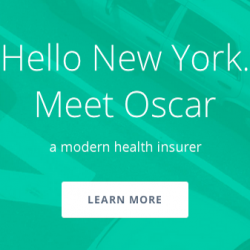

Americans do not usually think of health insurance as an intimate part of the care process. When sick, individuals do not call their insurance company for care or support. The health insurance industry is considered confusing, at best. The ACA however, presents an opportunity for the reformation of health insurance as we know it, not because of its disappearance, but by making it an integral part of receiving quality care. According to one co-founder, “We want consumers to feel like they have a doctor in the family.” That family doctor he speaks of is Oscar.
Oscar will have one plan in each of the ACAs metal-tiered categories, and additional plan options for the Bronze and Silver tiers. Although Oscar will have some of the familiar pillars of the health care industry like co-pays and deductibles for in-person visits, it introduces new elements like free telemedicine, free generic drugs and online price comparisons. Oscar health insurance will pioneer “a consumer experience, not a processor of claims,” explained Nazemi, with the goal of simply guiding individuals through the complex health system in an integrative and safe way.
Customer Service: What Oscar Can Do For You
Through user experience, customer service and innovative care options, Oscar will attempt to expand the role of the health insurance company to a health services provider. Oscar is being developed not just to cover medical costs, but to be the primary place to get the medical assistance a patient needs at any time.
When Oscar opens on the New York insurance exchange on October 1st, there will be a focus on function, ease of use and design. When a patient logs into HiOscar.com, he or she will want to keep using it like a new iPhone or laptop, or so the creators hope.
For frequent conditions or issues, patients will be able to find treatments right on the website and have 24/7 access to a physician through their unique partnership with the telemedicine company, TeleDoc. Additionally, the creators claim there will be no need to discuss prescription refills in-person with an expensive physician when a user can have “one-click refills” through a health records feed that resembles a Twitter timeline.
Oscar will also offer services at many hospitals and retail locations such as New York CVS CareMark. The partnership that Oscar and CVS have is so strong that CVS is building sites for Oscar. These added locations will serve as one method of addressing the physician deserts that exist in the state. The company also contends that Value Options is a strategic partner with the goal of making mental and behavioral health care more accessible for the newly insured.
Not everything will be brand new though. Oscar will offer several types of plans like traditional insurance companies, but the approach is slightly different. As Schlosser explains, “packages will be bundled like AT&T, which consumers are now accustomed to.” The intention is to eliminate many of the arcane rules of the insurance industry, which often frustrate patients and erode the customer service experience.
Schlosser tells a story of him, his wife and baby going to CVS in the fall of 2012 to get flu shots in New York City. Schlosser gets his shot, but when his wife goes for hers, she is rejected. The pharmacist explains that Mario’s insurance only covered one shot per 24 hours. Schlosser, who at the time was already working with Kushner and Nazemi on Oscar, explained that Oscar is designed specifically not to have such “Byzantine rules.”
Telemedicine: The Doctor Will See You Now
When describing key functions of their new company, Nazemi and Schlosser emphasize that telemedicine will be the method by which many of their objectives are accomplished. Although telemedicine has been around for a while, it has not been wildly popular with patients to date. Oscar hopes to change that feeling with new incentives, 24-hour online services and a sleek design.
The founders of Oscar claim that consumers will have access to a doctor by phone within 20 minutes of a request, with no co-pay. Perhaps the concept is not revolutionary, but if it works, the behavioral changes associated with seeking care could be seismic. Currently, not many patients log onto insurance carrier webpages before seeing a doctor, unless they are seeing if the doctor is in-network. Oscar, however, wants patients to start their care with the insurer, not just use it for payment submission.
Oscar also plans to have incentive programs such as the “10 for 10,” where patients will receive $10 for answering 10 questions about their health and preferences. The answers from those questions will then be used to establish proactive health care, as well as help the Oscar team make continual upgrades based on user preferences. For example, answers to the “10 for 10” might help create an outreach program for Diabetes patients where a registered nurse would come to the home, or the answers might inform web developers on how utilization could change in the future.
For added flexibility, Oscar asserts it will employ registered nurses and nurse practitioners to provide in-home follow-up services for patients if needed. In the case of new mothers, weekly visits to the home can be arranged if that is preferred over online interaction. Schlosser described his vision of this component as “integrating backwards,” where patients and providers interact in the settings they choose at the times they agree upon.
According to the creators, in addition to the partnership with TeleDoc, Oscar has already amassed some form of relationship with more than 83 hospitals in New York, hoping to make the telehealth to in-person relationship seamless.
Just How Transparent?
Transparency, the newest buzzword associated with the ACA, plays a dual role in the Oscar story. The availability of data drove Oscar’s operation and consumer focus, and has been an integral part of their ability to test their interface with government feedback. Schlosser describes tracking and analyzing years of medical claim data for entire episodes of care to help assess how technology and telemedicine may better treat patients. His go-to example relates to how many people use expensive physician time and technology for simple ailments like headaches, where large percentages of costs go to small percentages of patients.
Data analysis like Schlosser describes are only the beginning. As more medical data becomes available under the ACA, more and more relevant analyses will be conducted. The Oscar team is counting on this improved data to help them meet patient needs on the platform as well as potentially predict future health demands. Like their past Instagram endeavor, the group hopes to make data the backbone of sharing information.
Oscar’s creators were quick to stress that design and functionality are also deeply rooted in transparency. Schlosser explains that the interface will allow consumers to see price differences based on location, facility and desired services.
On Oscar, a user will supposedly be able to look up prices for doctors across the street from one another or shop for MRI pricing by facility. Schlosser boasts that patients will be able to view “heat maps of services and providers.” The question, however, of whether patients will actually log on to compare prices remains unanswered. Human behavior indicates that unless cost savings are passed on to the consumer, there is very little incentive to look for or care about alternatives.
Media Experts As Marketers
Oscar’s founders plan to target all uninsured in their market area. Based on Oscar’s innovative approach to insurance, and the creator’s unique backgrounds in social media, the marketing endeavor will surely be novel. Nazemi says that the approach to courting the uninsured will “include traditional and nontraditional forms of media,” with the ultimate goal being, “to win over every consumer.” This winning of the consumer, or patient, will include all of the feedback mechanisms and personal interaction that allow for real time updates to the company.
Although Oscar will be targeting the entire uninsured population in their New York market, it is likely that the young, healthy and social media savvy will be the easiest to penetrate with marketing materials. This population, however, has been of the greatest concern for the constructors of the ACA, and the reason the individual mandate exists. As time progresses we will see how Oscar uses its flexibility to attract and maintain a young and healthy population that is the least likely to pay for insurance.
Currently, the Oscar site is merely a welcome page and a list of open positions within the company. But, on October 1st, the site will be fully functioning, possibly putting other sites and insurers to shame. It is certain, given its creative employee background, that the feel and design of Oscar will be more user friendly than the state-based or federal sites.
According to Schlosser, the idea for consumer usage is to have a site where, “like Google, you can come use Oscar. You can type in your issue and we will help you find the best solution.” He explained that the entire experience will be interactive.
When asked about their role or faith in the success of the ACA, the team commented that, “the ACA is a catalyst for what we’re doing.” And the creators hope that Oscar will become a catalyst for the rest of the health insurance industry to be more transparent. They claim Oscar will set the stage for new expectations and behaviors by consumers, and that people already know they deserve more from their health care system.
Whatever the success of Oscar in the early stages of the exchange market in New York, one thing is for certain; Oscar has the potential to cause much needed disruption to health insurance and health care.
You can say hello to Oscar at HiOscar.com.


